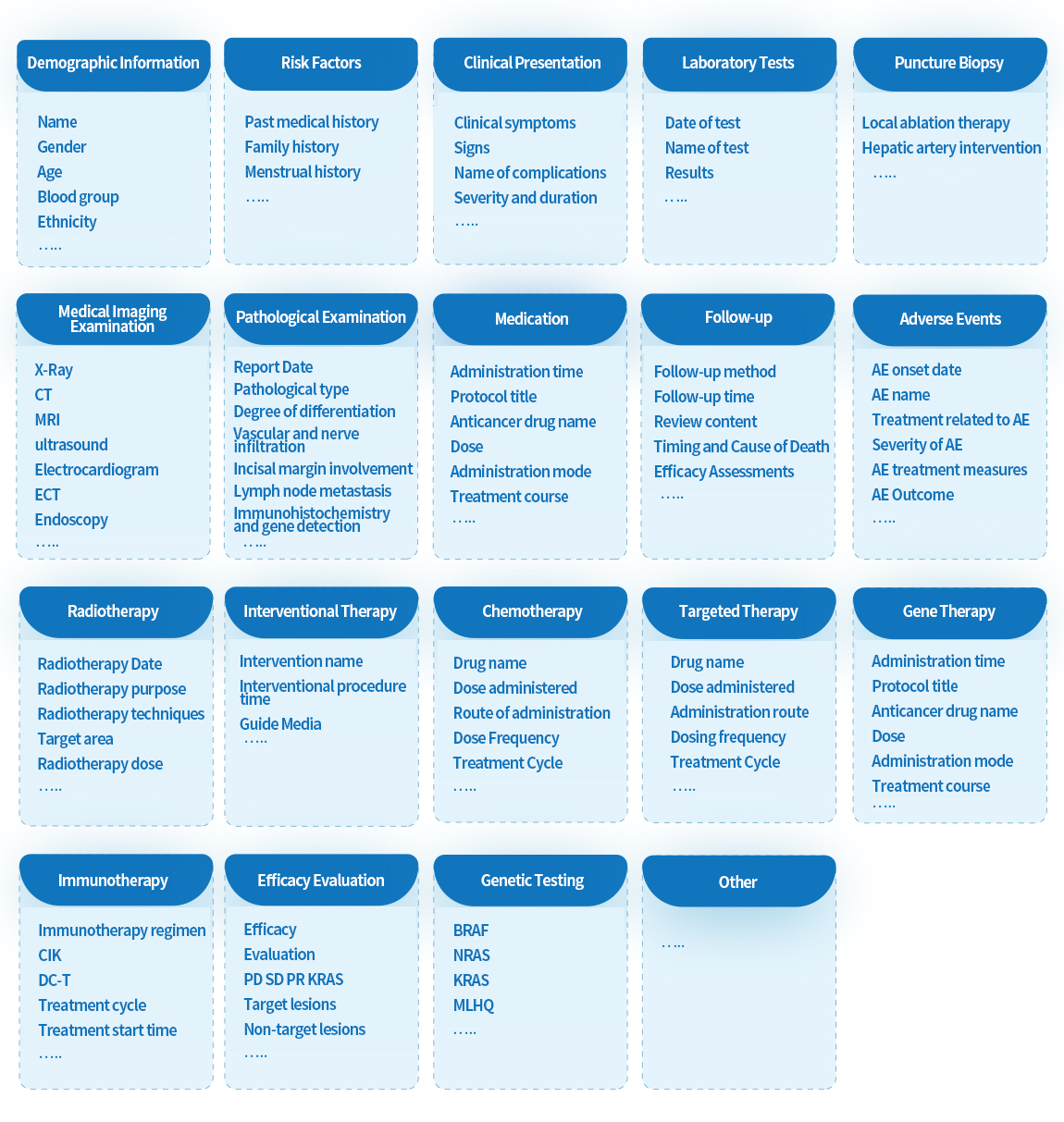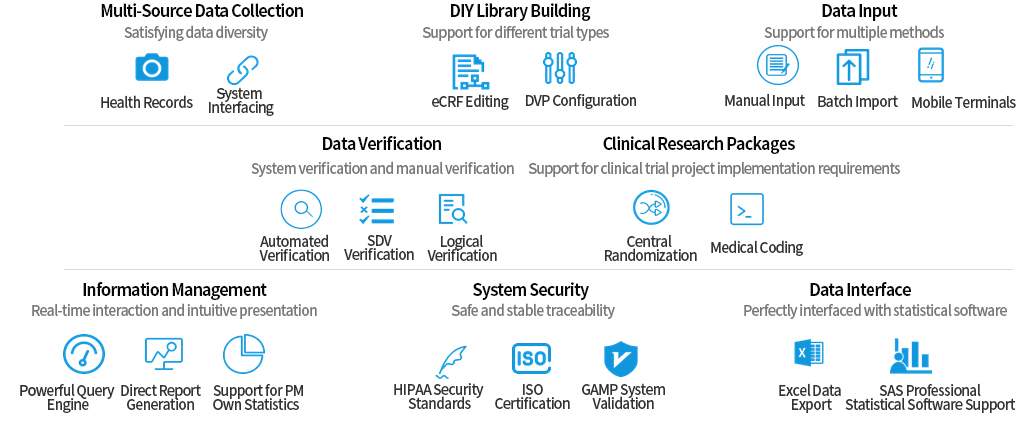l Single-patient data quality control.
l Convenient management and ease of data security.
l Participation in international and national multi-center clinical studies.
l Application for research funding projects.
l Rapid completion of research and fast production of papers.
l Real world research data base.
Through the construction of the MDT and telemedicine platform, the hospital completes the radiation of high-quality medical resources from point to plane, promotes the collaborative and coordinated development of various specialties across departments, enhances the comprehensive level of disease treatment and improves the patient's medical experience.
The MDT and telemedicine platform enables the sharing of medical images, medical tests, pathological examinations, medical electrocardiograms and other data and information. Through the transmission of audio and video images, as well as the tracking of the entire process of application, quality control, report uploading, treatment plan implementation and treatment effect analysis, the MDT provides practical services for the diagnosis of the condition of remote patients, the formation of accurate treatment plans, treatment implementation and post-rehabilitation, solving the problem of difficult and expensive access to medical services, thus allowing quality medical resources to continue to expand.
Meanwhile, the MDT and telemedicine platform offers telemedicine guidance, remote teaching and training, joint remote ward inspections, remote MDT and other functions to help lower-level hospitals, affiliated hospitals and helping hospitals to improve diagnosis and treatment as well as management level. The platform provides functions such as outpatient MDT, inpatient ward MDT and remote MDT. By forming MDT expert teams and integrating the advantages of teams with expertise in various disciplines, the platform enables experts with different professional backgrounds to design unique treatment plans for patients, so as to provide professional, precise, systematic, personalized, standardized and comprehensive, treatment services.
Clinical data is an important foundation for clinical research
Data management is one of the key aspects of quality control and quality assurance in clinical research. The acceptance of the results of a clinical study depends on the quality of the study data. Proper management of clinical research data ensures the integrity, reliability and accurate handling of the data, as well as the authenticity of the data.
Electronic clinical data is the trend
At present, more than 2/3 of clinical trials in the US are using EDC and the investment in EDC is increasing every year. The proportion of EDC use in clinical trials in China is also showing a yearly increase. Electronic management of clinical data seems to be the trend of clinical research development.
Metis accelerates the clinical trial process, reduces costs and improves quality
Metis provides an integrated EDC data management platform that changes the previous situation of slow data collection, lagging data verification, long trial cycles and poor data quality in paper-based clinical studies, resulting in faster trial processes, lower costs and higher quality.

International Common Data Modelling System
The adopted international common data model system of OHDSI OMOP CDM can better support hospitals’ information interconnection and international development strategies, promoting their inter-hospital collaboration at home and abroad.
Mainstream Terminology System for International Clinical Research
Supported by the mainstream terminology system for international clinical scientific research, SNOMED CT, an integrated ontology knowledge base of medical information in Chinese is constructed to achieve semantic derivation and retrieval, improving the capabilities of the rational utilization, mining and development of clinical data in hospitals.
Multi-omics and Multi-modal Data Fusion Technology
Multi-omics information fusion technology is used to integrate and analyze high-throughput omics data from multiple levels and sources. Multi-modality image integration technology is employed to support interconnection with all mainstream imaging equipment that complies with relevant imaging protocols and standards, to meet the requirements of interoperability and fusion analysis.
Natural Language Processing (NLP) Technology
Natural language processing (NLP) technology is used for post-structured processing and semantic analysis of medical records from hostiptals, to greatly improve the efficiency of data utilization and deeply mine the effective value of texts.
Protecting Privacy - Desensitization Technology
Referring to the compliance requirements of HIPPA international security and privacy, data is subject to strict privacy protection and desensitization processing. This technology supports desensitization at the data collection end in incremental and real-time ways, with flexible and configurable algorithms.
In recent years, the state has repeatedly issued policies to facilitate the development of multidisciplinary diagnosis and treatment (MDT) and telemedicine, including the launch of services nationwide and pilot services in local hospitals. With the deepening integration of the Internet+ and healthcare, the gradual commercialization of 5G technology, and the development of emerging industries such as artificial intelligence and big data, domestic hospitals are demanding higher levels of treatment, all of which will boost the development of MDT and telemedicine.
In recent years, the construction of MDT systems for multidisciplinary diagnosis and treatment has received unprecedented attention. MDT and telemedicine systems also played an important role in the Newcastle pneumonia epidemic, with telemedicine putting more quality medical resources into the epidemic remotely and supporting it. The outbreak was effectively controlled through joint discussions and communication between specialists from different departments. It seems that MDT and telemedicine systems are important for sharing quality medical resources, extending medical services, increasing medical coverage, improving medical standards in backward areas, reducing medical errors, enhancing standardized treatment of difficult and complex diseases, as well as education and training.


1. Seamless interface with hospital big data platform/hospital HIS, EMR, PACS and other business systems to create MDT with one click.
2. Support for automatic and manual association of images, annotation, measurement, MPR and other rich image viewing functions.
3. Abundant treatment effect BI and operational indicator BI statistics and analysis to provide continuous treatment for patients, improve hospital performance and support hospital research capabilities.
4. Accessing, sharing and viewing patient 360, viewing similar real cases and understanding the full patient history information.
5. Intelligent diagnosis and treatment evaluation, consultation evaluation, continuous improvement of diagnosis and treatment effectiveness, and optimisation of consultation process.
6. Abundant communication tools: live chat, audio and video group meetings, making remote consultations and MDT discussions more convenient.
7. Intelligent auxiliary diagnosis, literature knowledge base viewing function, assisting experts to give accurate and scientific treatment plans.
8. Support for remote clinical consultation, remote pathology diagnosis, remote imaging diagnosis, remote ECG diagnosis, remote MDT, remote teaching and other functions to fulfill the telemedicine needs of patients and medical institutions.
9. Personalized and customized treatment templates, death discussion templates, medical record templates and other extensive templates to enhance the efficiency of MDT discussions or remote consultations.
10. Intelligent MDT automatic screening into the group to facilitate standardized and process-oriented MDT activities in hospitals.
-- Cancer Hospital of the Chinese Academy of Medical Sciences (National Oncology Big Data Platform)
-- Nanfang Hospital (Tumor-Specific Database and Research Analysis System)
-- Xinjiang Cancer Hospital (Tumor-Specific Database and Research Analysis System)
-- Chongqing Cancer Hospital (Tumor-Specific Database and Research Analysis System)
-- Anhui Provincial Hospital (Heart Failure-Specific Database and Research Analysis System)
-- China Cardiovascular Association (iHeart Cardiovascular Research Analysis and Assistant Decision Support Platform)
-- Peking University First Hospital (Acute Kidney Injury (AKI) Specialized Database Research and Analysis System)
-- Peking Union Medical College Hospital ( National Rare Diseases Registry System of China, NRDRS)
-- Jiangsu Province Hospital (Clinical Research Analysis System)
-- The Second Affiliated Hospital of Nanchang University (Clinical Research Analysis System)
-- Guangji Psychiatric Hospital (Clinical Research Analysis System)
-- …
